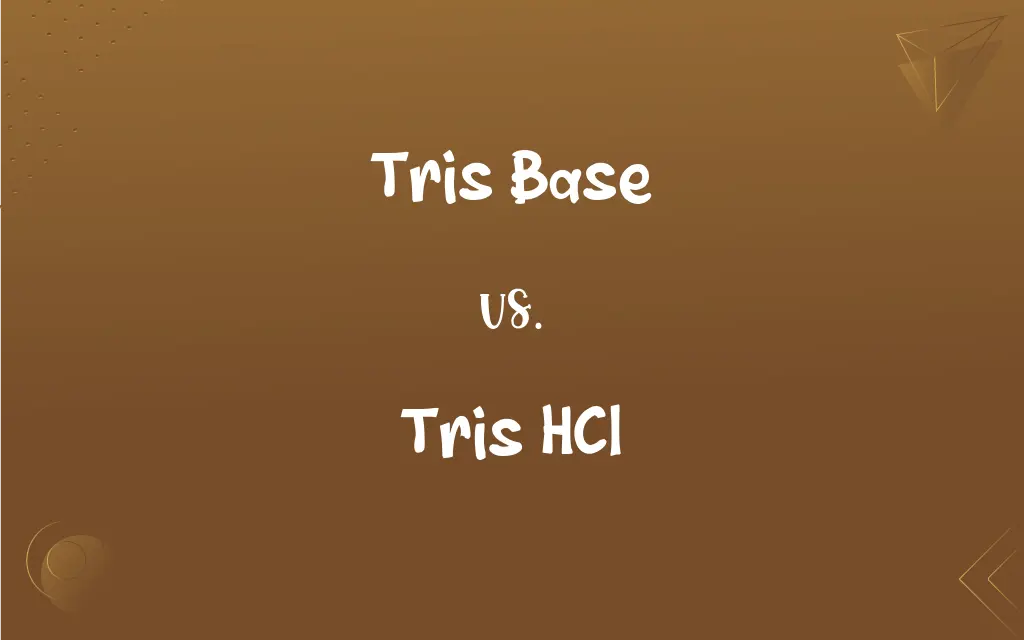Tris Base vs. Tris HCl: What's the Difference?
Edited by Aimie Carlson || By Janet White || Published on February 6, 2024
Tris Base is a common biochemical buffer, free of any counter ions, while Tris HCl is Tris Base reacted with hydrochloric acid, resulting in a chloride salt.

Key Differences
Tris Base, also known as tromethamine, is a primary amine used to prepare buffer solutions in biochemistry and molecular biology. Tris HCl, on the other hand, is the hydrochloride salt form of Tris, created by reacting Tris Base with hydrochloric acid.
The Tris Base is a weak base and is often used in its pure form to adjust pH in buffer solutions. In contrast, Tris HCl is typically used when a specific pH is desired, as it is a conjugate acid form of Tris.
Tris Base has a high buffering capacity in the pH range of 7.5-9.0, making it ideal for biological systems. Tris HCl, being a salt, is more soluble and stable, with its buffering range closer to neutral pH.
When using Tris Base, pH adjustments are often necessary, usually by adding acids or bases. Tris HCl, however, is often chosen for convenience as its pH is more predictable and stable once dissolved.
The choice between Tris Base and Tris HCl depends on the desired pH and ionic strength of the buffer solution, with Tris Base being more versatile and Tris HCl more specific in use.
ADVERTISEMENT
Comparison Chart
Chemical Nature
Weak base, no counter ions
Hydrochloride salt of Tris
PH Adjustment
Requires external pH adjustment
PH more predictable and stable
Buffering Capacity
High buffering capacity, pH 7.5-9.0
Buffering range closer to neutral pH
Solubility and Stability
Less soluble and stable compared to salt
More soluble and stable due to chloride ion
Usage
Versatile for various pH levels
Specific for applications near neutral pH
ADVERTISEMENT
Tris Base and Tris HCl Definitions
Tris Base
It is commonly used in its pure form for laboratory solutions.
Pure Tris Base was weighed for preparing the electrophoresis buffer.
Tris HCl
Tris HCl is the hydrochloride salt of Tris Base, used in buffer solutions.
Tris HCl was the chosen buffer for our enzyme assay.
Tris Base
Tris Base is a weakly basic compound used to make buffer solutions.
We used Tris Base to create a buffer for our DNA extraction process.
Tris HCl
It results from the reaction of Tris Base with hydrochloric acid.
We prepared Tris HCl by adding hydrochloric acid to Tris Base.
Tris Base
It is a primary amine, often used in biochemistry for pH control.
Tris Base was added to adjust the pH of the solution to 8.0.
Tris HCl
Tris HCl offers more predictable pH stability than Tris Base.
The predictable pH of Tris HCl made our experiment more reliable.
Tris Base
Tris Base has a high buffering capacity, particularly in alkaline conditions.
The buffer's stability was maintained by the Tris Base's buffering capacity.
Tris HCl
Tris HCl is more soluble and stable due to its chloride ion.
The chloride ion in Tris HCl improved the solubility of our buffer solution.
Tris Base
Tris Base is versatile for different pH levels in biochemical applications.
We chose Tris Base for its versatility across different experiments.
Tris HCl
It has a buffering range close to neutral pH, suitable for many biological reactions.
Tris HCl was perfect for our reaction, which required a near-neutral pH.
FAQs
What is Tris Base used for?
Tris Base is used to prepare buffer solutions in biochemistry and molecular biology.
Is Tris HCl more soluble than Tris Base?
Yes, Tris HCl is more soluble due to the presence of the chloride ion.
What pH range is Tris Base best for?
Tris Base is best used for buffering in the pH range of 7.5 to 9.0.
How do you prepare a Tris Base buffer?
Prepare a Tris Base buffer by dissolving Tris Base in water and adjusting the pH with an acid or base.
How is Tris HCl different from Tris Base?
Tris HCl is the hydrochloride salt form of Tris Base, offering more stable pH levels.
Can Tris Base adjust pH on its own?
No, Tris Base requires external acids or bases to adjust its pH.
How do you adjust the pH of a Tris Base solution?
Adjust the pH of a Tris Base solution by adding hydrochloric acid or sodium hydroxide as needed.
Is Tris HCl a good choice for high-temperature experiments?
Tris HCl can be used in high-temperature experiments, but its buffering capacity may decrease with increasing temperature.
Why would one choose Tris HCl over Tris Base?
Tris HCl is chosen for its predictable pH and stability, particularly near neutral pH.
Does Tris HCl have a high buffering capacity?
Yes, Tris HCl has a good buffering capacity, especially around neutral pH.
Can Tris HCl affect enzyme activities in experiments?
Yes, the pH of Tris HCl can influence enzyme activities, so it should be chosen carefully based on the enzyme's pH optimum.
Can Tris Base and Tris HCl be used interchangeably?
They are not interchangeable; the choice depends on the specific requirements of the experiment, particularly pH.
Can Tris Base be used for acidic solutions?
Tris Base is less effective in acidic conditions and is better suited for alkaline environments.
Is Tris HCl suitable for all pH ranges?
Tris HCl is most suitable for buffering around neutral pH and may not be ideal for extreme pH values.
What is the chemical formula of Tris Base?
The chemical formula of Tris Base is C₄H₁₁NO₃.
Are there any safety concerns with Tris Base?
Tris Base should be handled with care, avoiding inhalation and contact with skin or eyes.
Can Tris HCl buffer acidic solutions effectively?
Tris HCl is less effective in highly acidic conditions and is better for near-neutral pH solutions.
How does chloride in Tris HCl affect its use in experiments?
The chloride ion in Tris HCl can influence ion-sensitive reactions and should be considered when designing experiments.
What is the storage recommendation for Tris HCl?
Store Tris HCl in a cool, dry place, away from direct light and moisture.
What types of biological samples are buffered with Tris Base?
Tris Base is commonly used to buffer DNA, RNA, and protein samples.
About Author
Written by
Janet WhiteJanet White has been an esteemed writer and blogger for Difference Wiki. Holding a Master's degree in Science and Medical Journalism from the prestigious Boston University, she has consistently demonstrated her expertise and passion for her field. When she's not immersed in her work, Janet relishes her time exercising, delving into a good book, and cherishing moments with friends and family.
Edited by
Aimie CarlsonAimie Carlson, holding a master's degree in English literature, is a fervent English language enthusiast. She lends her writing talents to Difference Wiki, a prominent website that specializes in comparisons, offering readers insightful analyses that both captivate and inform.







































































